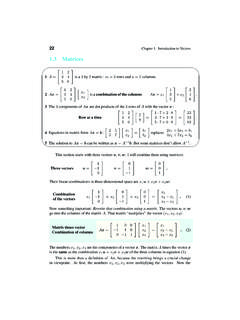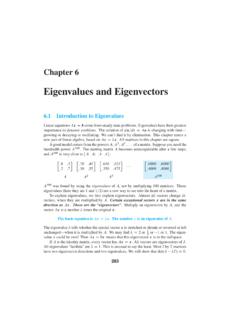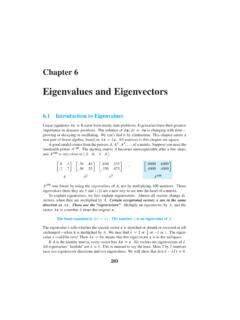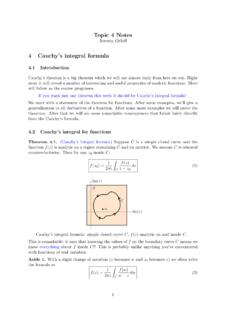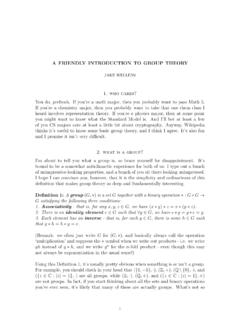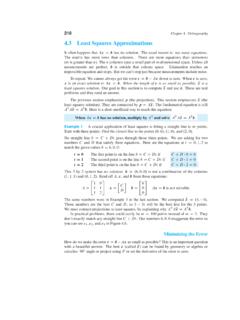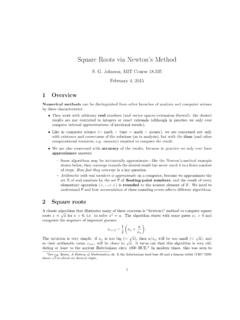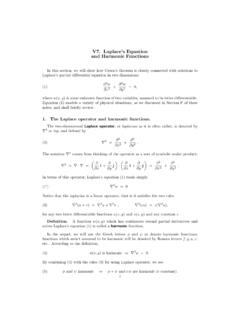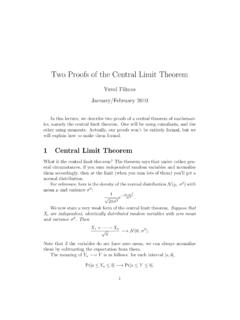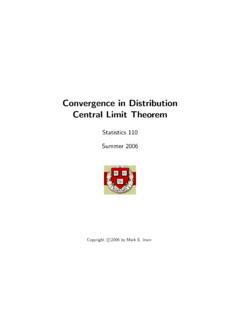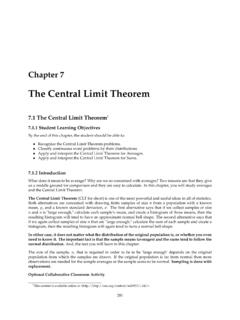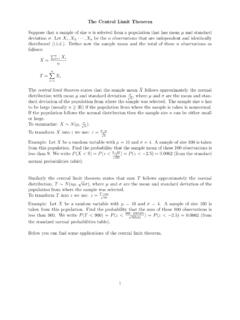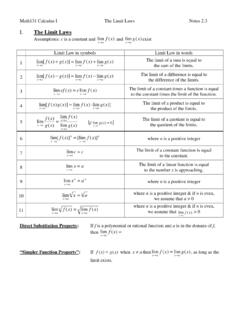Transcription of The Limit of a Sequence - MIT Mathematics
1 3 The Limit of a Definition of Chapter 1 we discussed the Limit of sequences that were monotone; thisrestriction allowed some short-cuts and gave a quick introduction to the many important sequences are not monotone numerical methods, for in-stance, often lead to sequences which approach the desired answer alternatelyfrom above and below. For such sequences, the methods we used in Chapter 1won t work. For instance, the , .9, , .99, , .999, ..has 1 as its Limit , yet neither the integer part nor any of the decimal places of thenumbers in the Sequence eventually becomes constant. We need a more generallyapplicable definition of the abandon therefore the decimal expansions, and replace them by the ap-proximation viewpoint, in which the Limit of{an}isL means roughlyanis a good approximation toL, whennis following definition makes this precise. After the definition, most of therest of the chapter will consist of examples in which the Limit of a Sequence iscalculated directly from this definition.
2 There are Limit theorems which help indetermining a Limit ; we will present some in Chapter 5. Even if you know them,don t use them yet, since the purpose here is to get familiar with the numberLis thelimitof the Sequence {an}if(1)given >0,an Lforn such anLexists, we say{an}converges, oris convergent; if not,{an}diverges,oris divergent. The two notations for the Limit of a Sequence are:limn {an}=L;an Lasn .These are often abbreviated to: liman=Loran (1) looks short, but it is actually fairly complicated, and a fewremarks about it may be helpful. We repeat the definition, then build it in threestages, listed in order of increasing complexity; with each, we give its translationinto to AnalysisDefinition : given >0, an Lforn this up in three succesive stages:(i)an L(anapproximatesLto within );(ii)an Lforn 1 the approximation holds for allanfar enough out in the Sequence ; ;(iii) given >0,an Lforn 1(the approximation can be made as close as desired, pro-vided we go far enough out in the Sequence the smaller is, the farther out we must go, in general).
3 The heart of the Limit definition is the approximation (i); the rest consists ofthe if s, and s, and but s. First we give an limn n 1n+ 1= 1 , directly from definition to definition , we must show:(2)given >0,n 1n+ 1 1 forn begin by examining the size of the difference, and simplifying it: n 1n+ 1 1 = 2n+ 1 =2n+ want to show this difference is small ifn 1. Use the inequality laws:2n+ 1< ifn+ 1>2 , , ifn > N,whereN=2 1 ;this proves (2), in view of the definition ( ) of forn 1 . The argument can be written on one line (it s ungrammatical, but easier towrite, print, and read this way) >0, n 1n+ 1 1 =2n+ 1< , ifn >2 1. Remarks on Limit The heart of a Limit proof is in the approximation statement, , ingetting a small upper estimate for|an L|.Often most of the work will consistin showing how to rewrite this difference so that a good upper estimate can bemade.
4 (The triangle inequality may or may not be helpful here.)Note that in doing this, youmustuse| |; you can drop the absolute valuesigns only if it is clear that the quantity you are estimating is In giving the proof, you must exhibit a value for theNwhich is lurking inthe phrase forn 1 . You need not give the smallest possibleN; in , it was 2/ 1, but any bigger number would do, for exampleN= 2/ .Note thatNdepends on : in general, the smaller is, the biggerNis, ,the further out you must go for the approximation to be valid within .Chapter 3. The Limit of a Sequence373. In Definition of Limit , the phrase given >0 has at least fiveequivalent forms; by convention, all have the same meaning, and any of them canbe used. They are:for all >0 , for every >0 , for any >0 ;given >0 , given any >0 .The most standard of these phrases is for all >0 , but we feel that ifyou are meeting (1) for the first time, the phrases in the second line more nearlycapture the psychological meaning.
5 Think of alimit demonwhose only purpose inlife is to make it hard for you to show that limits exist; it always picks unpleasantlysmall values for . Your task is, given any the Limit demon hands you, to find acorrespondingN(depending on ) such thatan Lforn > : the Limit demon supplies the ; you cannot choose it writing up the proof, good mathematical grammar requires that you write given >0 (or one of its equivalents)at the beginning; get in the habit now ofdoing it. We will discuss this later in more detail; briefly, the reason is that theNdepends on , which means must be named It is not hard to show (see Problem 3-3) that if a monotone Sequence {an}has the limitLin the sense of Chapter 1 higher and higher decimal placeagreement thenLis also its Limit in the sense of Definition (The converseis also true, but more trouble to show because of the difficulties with decimalnotation.) Thus the Limit results of Chapter 1, the Completeness Property inparticular, are still valid when our new definition of Limit is used.
6 From now on, Limit will always refer to Definition is another example of a Limit proof, more tricky than the first limn ( n+ 1 n) = 0 . use the identityA B=A2 B2A+B, which tells us that(3) ( n+ 1 n) =1 n+ 1 + n<12 n;given >0,12 n< if14n< 2, , ifn >14 2. Note that here we need not use absolute values since all the quantities are is not at all clear how to estimate the size of n+ 1 n; the triangle inequalityis useless. Line (3) is thus the key step in the argument: the expression must firstbe transformed by using the identity. Even after doing this, line (3) gives a furthersimplifying inequality to make finding anNeasier; just try getting anNwithout thisstep! The simplification means we don t get the smallest possibleN; who cares?38 Introduction to AnalysisQuestions Directly from the definition of Limit ( , without using theorems aboutlimits you learned in calculus), prove that(a)nn+ 1 1(b)cosnan 0 (ais a fixed number)(c)n2+ 1n2 1 1(d)n2n3+ 1 0 cf.
7 Example : makea simplifying inequality 2. Prove that, for any Sequence {an}, liman= 0 lim|an|= 0.(This is a simple but important fact you can use from now on.)3. Why does the definition of Limit say >0, rather than 0 ? The uniqueness of limits . The K- a Sequence have more than one Limit ? Common sense says no: if therewere two different limitsLandL , theancould not be arbitrarily close to both,sinceLandL themselves are at a fixed distance from each other. This is the ideabehind the proof of our first theorem about limits . The theorem shows that if{an}is convergent, the notation limanmakes sense; there s no ambiguity aboutthe value of the Limit . The proof is a good exercise in using the definition of limitin a theoretical argument. Try proving it yourself Uniqueness theorem for sequenceanhas at most one Limit :an Landan L L=L . hypothesis, given >0,an Lforn 1,andan L forn , given >0, we can choose some large numberksuch thatL ak L.
8 By the transitive law of approximation ( (8)), it follows that(4)given >0, L 2 L .To conclude thatL=L , we reason indirectly (cf. Appendix ).SupposeL6=L ; choose =12|L L |. We then have|L L |<2 ,by (4); ,|L L |<|L L |,a contradiction. The line (4) says that the two numbersLandL are arbitrarily close. Therest of the argument says that this is nonsense ifL6=L , since they cannot becloser than|L L |.Chapter 3. The Limit of a Sequence392. Before, we emphasized that the Limit demon chooses the ; you cannotchoose it yourself. Yet in the proof we chose =12|L L |. Are we blowing hotand cold?The difference is this. Earlier, we were trying to prove a Limit existed, ,were trying to prove a statement of the form:given >0, some statement involving is do this, you must be able to prove the truth no matter what you are on the other hand, we don t have to prove (4) we already deduced itfrom the hypothesis. It s a true statement.
9 That means we re allowed touseit,and since it says something is true for every >0, we can choose a particularvalue of and make use of its truth for that particular reinforce these ideas and give more practice, here is a second theoremwhich makes use of the same principle, also in an indirect proof. The theorem is obvious using the definition of Limit we started with in Chapter 1, but we arecommitted now and for the rest of the book to using the newer Definition oflimit, and therefore the theorem requires proof.{an}increasing, L= liman an Lfor alln; theorem {an}decreasing, L= liman an Lfor cases are handled similarly; we do the indirectly, suppose there were a termaNof the Sequence such thataN> L. Choose =12(aN L). Then since{an}is increasing,an L aN L > ,for alln N,contradicting the Definition ofL= liman. The K- the proof of theorem , note the appearance of 2 in line (4). It oftenhappens in analysis that arguments turn out to involve not just but a constantmultiple of it.
10 This may occur for instance when the Limit involves a sum orseveral arithmetic processes. Here is a typical +sinnn+ 1. Showan 0, from the showanis small in size, use the triangle inequality: 1n+sinnn+ 1 1n + sinnn+ 1 .At this point, the natural thing to do is to make the separate estimations 1n < ,forn >1 ; sinnn+ 1 < ,forn >1 1 ;so that, given >0, 1n+sinnn+ 1 <2 ,forn >1 .This is close, but we were supposed to show|an|< . Is 2 just as good?40 Introduction to AnalysisThe usual way of handling this would be to start with the given , then put = /2, and give the same proof, but working always with instead of . Atthe end, the proof shows 1n+sinnn+ 1 <2 ,forn >1 ;and since 2 = , the Limit definition is of doing this, let s once and for all agree that if you come out in theend with 2 , or 22 , that s just as good as coming out with.
